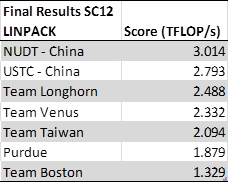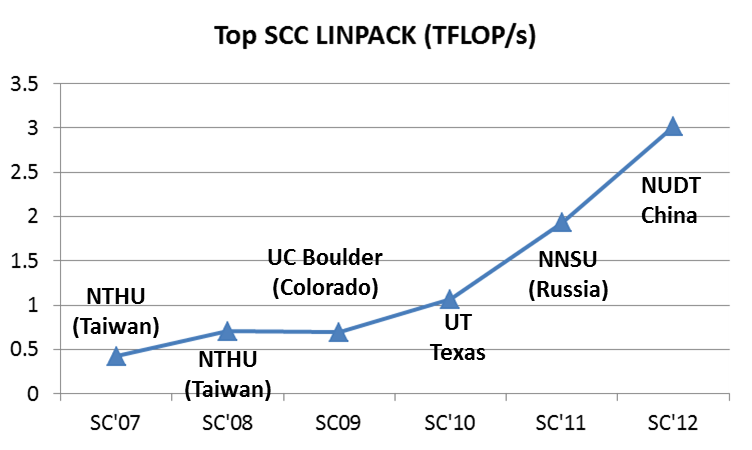Salt Lake City is abuzz with the news that China’s NUDT team has once again snared the LINPACK crown at a student cluster competition. Their record-breaking score of 3.014 TFLOP/s topped their competitors and marked the first time a student cluster team has broken through the 3 TFLOP/s barrier.
This is the second LINPACK win in less than a year for NUDT – they took this award at the ISC’12 competition in Hamburg as well. Teams from China took both of the top slots, followed by Team Longhorn at 2.488 TFLOP/s.
Student clustering buffs might remember that Team Longhorn was one of the first teams to achieve a TFLOP in the 2010 competition in New Orleans, so it’s not surprising to see them in the top echelon here.
I was surprised to see Team Venus land the number four spot, beating out more experienced competitors. It’s a great result given their relative inexperience with HPC and clustering in general. Team Taiwan and Team Boilermaker hold down the fifth and sixth slots. I suspect that we’re seeing some strategy at work here.
Under the SCC rules, teams have almost no ability to make changes to their hardware once they settle on their final configuration. In other words, they can’t run a whole bunch of power-hungry GPUs for a certain workload and then physically detach them or put them to sleep in order to save power when running other, less GPU-friendly workloads.
This makes sense – it ensures that the 26 amp power cap actually has teeth. As a result, some teams might configure their system in a way to perform better on scientific applications (which will make up the majority of their overall score) rather than capture the highest LINPACK.
This rule turned out to have an effect on Team Chowdah’s (Boston) LINPACK score. Because they weren’t allowed to put certain components and nodes to sleep, they had to power down two nodes completely. This means that they were two nodes short of their full system on both the LINPACK and application runs – which will definitely throw some sand in their chowder.
While this definitely had an impact on LINPACK, we’re not sure exactly what this means for their scientific application runs. In other words, they still have a puncher’s chance at the overall SCC crown. (Even though there isn’t a real crown.)
More SCC History
I plotted out the history of LINPACK scores since the inaugural SCC way back in November of 2007 in Reno. After the first few years, it’s been a satisfyingly steep ramp up from SC09 (.7 TFLOP/s) to today’s huge score of just over 3 TFLOP/s.
Here’s a test question for the readers: Is the growth in LINPACK scores by the SCC teams larger or smaller than what we’d expect to see with Moore’s Law?
Posted In: Latest News, SC 2012 Salt Lake City
Tagged: SC 2012, Student Cluster Competition, SCC, LINPACK, National University of Defense Technology, NUDT, Moore's Law, Results


